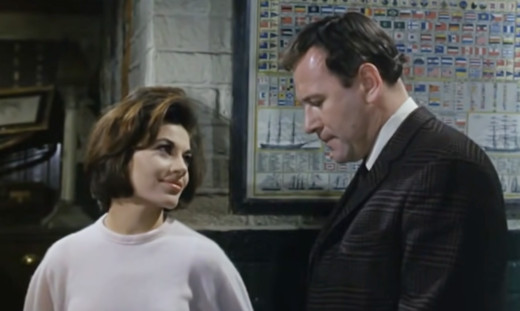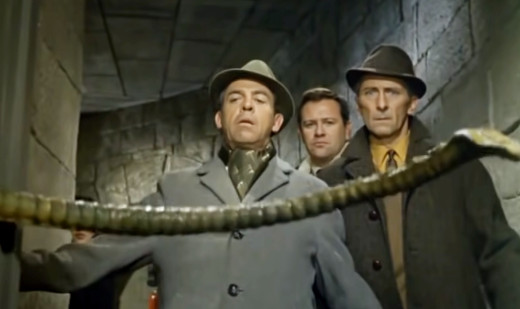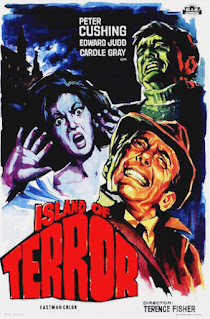Pros: Effectively builds tension through to a nail-biting climax; Clever, unexpected ending; Stars Peter Cushing (enough said)
Cons: Set-up of a completely isolated island requires a big suspension of disbelief; In the light of day, the creatures are underwhelming
This is my contribution to the 10th annual Rule, Britannia blogathon hosted by Terence at A Shroud of Thoughts. Once you’re done exploring the Island of Terror, head over to Terence’s site to check out posts on a fascinatingly wide range of British films spanning the decades.
Please bear with me while I do my pretend-to-know-it-all-when-all-I-do-is-paraphrase-from-Wikipedia thing. The British Isles, situated in the North Atlantic a relative stone’s throw northwest of continental Europe, consist of the big a** island we all know and love, Great Britain, along with Ireland, the Isle of Man, the Inner and Outer Hebrides, the Northern Isles of Orkney and Shetland, and over 6,000 (!!) smaller islands (Ireland is not too keen on being included in the group, but that’s a story for another day).
When we’re talking about thousands of remote, windswept islands dotting the coasts in the frigid North Atlantic, you know that at least a representative few are going to turn up in folklore, mystery stories, and of course, horror films.
In the current British crime drama Shetland, the Northern Isles have overtaken Cabot Cove, Maine as the murder capital of the world.
Movies haven’t been far behind in exploiting the remote British island mystique. In Tower of Evil (aka Horror on Snape Island, 1972), treasure hunters encounter murder and mayhem on a desolate island dominated by an abandoned lighthouse.
And who can forget Summerisle, the quietly eerie setting for the greatest island horror story of them all, The Wicker Man (1973)?
 |
| There's nothing like balmy island breezes rustling through your hair as you prepare for your next sacrifice. |
The ‘60s also saw its share of British island horror. Britain’s Planet Film Productions, which made a mere handful of low-budget films in the ‘50s and ‘60s, is responsible for two notable entries in the sub-subgenre.
Back in May 2021, I reviewed Planet Films’ Night of the Big Heat (aka Island of the Burning Damned, 1967) for a Christopher Lee blogathon. Island of Terror and Night were the last two films that Planet Films made before folding. Planet’s producers seemed to have islands on the brain, but it’s not as if they were trying to maximize an ideal exotic location - both films were mostly shot at Pinewood Studios on the mainland.
For these final two efforts, Planet managed to secure the services of director Terence Fisher and Peter Cushing, who had teamed up to make the iconic horror films that propelled Hammer Studios to world notoriety; the addition of Christopher Lee to the 1967 film completed the Hammer horror alum trifecta.
Boomer fans could be forgiven for mixing these two up in their remembrances of things (and creature features) past. Let’s look at the similarities:
- Both star Peter Cushing with Terence Fisher directing
- Both are set on remote islands off the coast of Great Britain
- Both islands are the home to research installations (civilian in Island, military in Night) that are the targets of local gossip
- The islands are menaced by mysterious creatures that are first heard before they are seen
- The first unfortunate victim dies in a cave
- The islanders are trapped with no boat or air service scheduled for days, and no way to contact the mainland
- The protagonists use the island’s inn as a makeshift headquarters for planning how to deal with the menace
- When the creatures are finally revealed, they’re decidedly underwhelming
Night of the Big Heat adds an additional element of suspense by featuring an unusual heat wave that blankets the island in the middle of winter (unusual, since the island is located off the chilly northern coast of Scotland). Along with the temperature, tension rises as an attractive former flame of the married innkeeper's arrives on the island to try to pick up where they left off.
 |
| Christopher and Peter consider giving their island B&B a scathing review on Tripadvisor. |
But hey, I’m supposed to be writing about Island of Terror here. Island forgoes the torrid love triangle, choosing instead to give one of its protagonists a beautiful girlfriend who, while insisting on getting in on the excitement, is unfortunately not much help when the chips are down (more on that later).
In a pre-titles sequence, we learn that a mad doctor (er, make that enthusiastic Dr. Phillips, played by Peter Forbes-Robertson) has set up a fancy laboratory on Petrie’s island (between Ireland and Great Britain) in order to experiment with cell cultures as a cure for cancer.
Right on cue, one of the local farmers, out doing farmer-type things, hears a weird trilling sound and innocently follows the sound into a dark cave, whereupon he screams bloody murder. When the man is reported missing, Constable Harris (Sam Kydd) starts searching and soon discovers a body that is **GULP** nothing but a boneless bag of flesh.
The local physician, Doc Landers (Eddie Byrne), astonished that all the bones in the body appear to have dissolved, nonetheless confirms from a tattoo that it’s the remnants of the missing farmer.
To say the least this is way beyond Landers’ paygrade, so he travels to London to enlist the aid of two medical experts, Drs. Brian Stanley and David West (Peter Cushing and Edward Judd). West, a ‘60s swinging playboy-type, has a young woman, Toni Merrill (Carole Gray) with him, who is fascinated by the story of the boneless man.
 |
| Taking a break from monster hunting, Toni and David decide to brush up on their knowledge of nautical flags. |
When the three men start discussing how to get back to the island forthwith, Toni, a wealthy heiress, offers them the use of her father’s helicopter on one condition: that she ride along. After some half-hearted paternalistic demurrals that it’s too dangerous (cue eye roll), the doctors accept Toni’s offer.
As they’re preparing to board, Toni apologizes that her father needs the helicopter for a business trip, so after they’re dropped off it won’t be available for several days (cue the ominous music…).
Back at Landers’ surgery, Stanley and West notice tiny puncture marks all over the boneless body, suggesting that, after the bones were dissolved, the remnant calcium phosphate was **GULP** sucked out of the body.
Being smart people, the doctors suspect that there may be a connection between the biomedical research being conducted on the island and the boneless body, so they head over to Phillips’ laboratory. To their horror, they find the place littered with the dessicated bodies of Phillips and his staff.
The doctors collect all the lab notes they can find and take them back to the inn, where they can quaff a pint or two while trying to figure out what’s going on. (For more insight on the traditional inn/pub as a refuge in British horror and sci-fi films, see my post on The Earth Dies Screaming.)
 |
| The three doctors confer over the mystery of the boneless bodies. |
Meanwhile, another local finds one of his horses dead, minus its bones. Before you can say “bloody bone-liquefying mutants,” the intrepid investigators discover that Phillips’ experiments in creating living cells to combat cancer had gone horribly wrong, instead creating nightmarish tortoise-sized silicate-based creatures with tentacles that allow them to seize their prey and drain them of their calcium.
To add insult to bone-putrefying injury, after feeding, the things split in two. As the calcium phosphate starts to hit the fan, West estimates that at their current rate of reproduction, within a week Petrie’s island will become a gigantic petri dish with a million or more silicates slithering around.
With the casualty rate mounting, Stanley and West convince the surviving islanders to hole up in the town hall, and Toni is tasked with holding down the fort while the men, with the help of the island’s mayor (Niall MacGinnis), battle the creatures with Molotov cocktails and dynamite.
When that fails, it’s back to the drawing board to try and figure out how to poison the nasty armor-plated things. Phillips’ laboratory might just hold the key, but getting there and back is not going to be easy.
 |
| If you can handle it, click on the image to see the hideous thing this tentacle belongs to! |
With a limited budget for creature effects, Island of Terror compensates with a slow, steady building of tension as the protagonists investigate the mystery, then ramps up the claustrophobia and desperation as the silicates surround the villagers trapped in the town hall.
In the first half, the writers seed the script with a minefield of circumstances that all converge at the climax: the island is inaccessible except by a ferry boat that comes once a week; once the helicopter drops off the protagonists, it’s unavailable for several days; there’s only one generator for the whole island; and most head-scratching of all, nobody seems to own a two-way radio or a boat of their own.
Even acknowledging that island living in the ‘60s lacked many of today’s amenities, it’s hard to imagine a populated island with medical facilities, a general store, livestock, a town hall, and an advanced research lab having no way to get to or contact the mainland, even under the worst of circumstances.
So, to enjoy your visit to the Island of Terror, it’s necessary to suspend a sizable amount of disbelief and immerse yourself in an alternate universe that looks a lot like ours, but has rules of its own.
There’s plenty to enjoy if you’re up for it. The silicates are pretty simple creatures, looking like a headless tortoise with a single squid-like tentacle for feeling out and grabbing prey. What they lack in speed, they make up for in stealth and reproductive ability.
The real gross-out moments come when the remains of the silicates’ meals are discovered. It’s easy to get a little queasy the first time around, when Constable Harris uses his nightstick to prod at the corpse of his neighbor, which squishes flat. Later kills are supplemented with sucking and slurping sounds that poke at the imagination in disturbing ways.
 |
| Doc Phillips' wife wanted him to lose weight, but not like this. |
Effective too is the growing claustrophobia and panic as the islanders cram into the town hall to wait out the silicates' assault. The faltering generator adds to the tension as the doctors and the mayor try to calm everyone down. (Fans of strong female characters will be disappointed that Toni isn’t given more to do; she is supposed to organize the makeshift shelter and help maintain clam, but she herself is an emotional mess -- understandably so -- and by the end is passively awaiting her fate as the silicates break into the hall.)
Under all the pressure, the vaunted British stiff upper lip starts to quaver, to the point that the mayor has to threaten to shoot anyone who tries to make a run for it. Predictably, the characters who can’t handle the pressure-cooker become the architects of their own grisly demise.
 |
| "I'll shoot the next person who makes fun of the special effects!" |
In his study of Terence Fisher, film scholar Peter Hutchings drew comparisons between the locals in Island and those in Fisher’s Gothic Hammer horrors:
“Some of the attitudes on display in Island of Terror are recognizable from Fisher’s other work. Most notably, the community under threat turns out to be incapable of organising its own defence and consequently is in desperate need of leadership. This becomes strikingly apparent in the climactic scene when the community is trapped in a building where the power supply might fail. One of the community leaders, worried about the prospect of such a failure, comments on his charges, ‘They’re frightened without a light.’ We are not a million miles away here from the fearful peasants in Dracula, The Brides of Dracula and The Gorgon.” [Peter Hutchings, Terence Fisher (British Film Makers series), Manchester University Press, 2001, p. 130]
As for the heroes who take charge, Peter Cushing is there, but almost a decade out from his debut as the energetic vampire hunter Van Helsing, Cushing’s stint on the Island of Terror is all cerebral problem solving, and by the end, even he has been reduced to recuperating and passively observing due to a close encounter with a silicate.
 |
| After his close brush with bone-liquefying death, Peter begins to believe vampires aren't so bad after all. |
The last hero standing is the playboy, Dr. West, but in spite of his relative youth and good looks, there’s no real physical derring-do for his character either -- just dry science, educated guesses and tiptoeing around the slow-moving monsters. At the end, It’s up to West to voice a sort of “whistling in the dark” epitaph: “Science has its risks, but the risks aren’t enough to hinder progress.” Cleverly, the film completely undercuts West’s guarded optimism with an epilogue that, without going into too much detail, is eerily prescient of the Covid age.
I won’t go into Peter Cushing’s resume here, as it is well-known (or at least should be) to even casual fans. Edward Judd has been profiled on the blog before, playing a harried investigative reporter in the frighteningly realistic end-of-the-world saga The Day the Earth Caught Fire (1961; see the review here). Other notable sci-fi and horror stints include First Men in the Moon (1964), The Vengeance of She (1968) and Amicus’ portmanteau horror film The Vault of Horror (1973).
Carole Gray and Eddie Byrne have also graced these web pages before; see my review of Planet Film’ Devils of Darkness (1965), which pays very effective homage to Hammer’s Gothic horrors (Gray plays a seductive vampire and Byrne is a Van Helsing-type doctor).
Unfortunately, veteran Niall MacGinnis, who was so diabolically good as the modern-day warlock Karswell in Curse of the Demon (1957), is comparatively colorless and subdued in Island, at least until the fateful climax when he has to train his shotgun on his neighbors to keep them in line.
I have a confession to make. While Island of Terror is better known than Night of the Big Heat and is more highly rated by fans/audiences on IMDb and Rotten Tomatoes, I like Night a little bit more. The love triangle adds some figurative heat to the drama, the lead women characters are more three-dimensional (and in one case especially, more heroic), there are some surprises regarding who survives and who doesn’t, and lastly, there’s the added presence of Christopher Lee.
But don’t take that as advice to skip Island. It builds the tension up nicely to the climactic scene in the town hall, and once you finish guffawing at the silicates, their eating habits are entertainingly loathsome.
Where to find it: Streaming | DVD/Blu-ray


